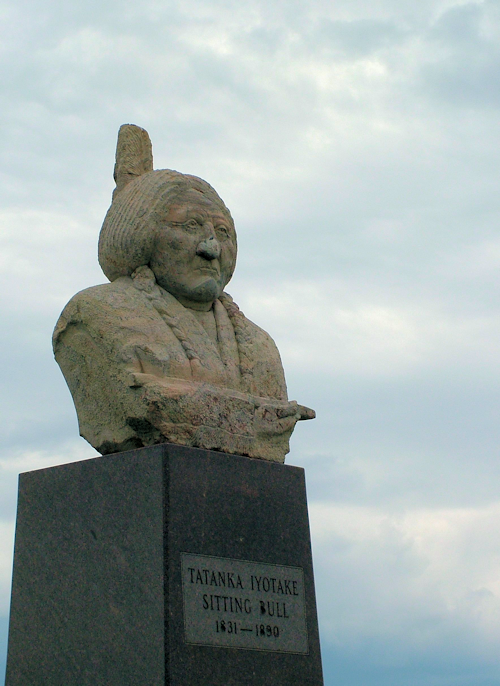
Pierre, capital of South Dakota (and pronounced Pier) deserved more than the morning I’d allocated it. It’s the second smallest state capital after Montpelier, Vermont, but it still boasts what must be one of the better museums in the midwest as well as the impressive state capitol itself.
For Lewis & Clark fans, as I’m sure you all are by now, Pierre was the site of a major episode in the voyage of discovery. At the mouth of what Clark named Bad River (you can already tell this isn’t going to end well), the Corps had its first encounter with the Teton Sioux. This was the most feared tribe along the Missouri, and it controlled trade. They were actually fairly recent blow-ins to the area from the Minnesota area, but they quickly exerted their power and were the dominant force on the plains. Jefferson had singled them out and wanted Lewis & Clark to do all they could to ensure the Sioux acquiesced to the will of the United States.
After an initial meeting with the Teton Sioux failed to make much headway – hindered by the fact that the Corps’ Lakhota interpreter was back in Yankton with the more amenable Yankton Sioux – things took a decidedly nasty turn. Out on the sandbar in the river where they were meeting, one of the chiefs tried to commandeer one of the pirogues and demanded that all its possessions were handed over to him. Clark drew his sword and the guns on the keelboat swivelled into position. A tense stand-off ensued until Chief Black Buffalo intervened and ordered the others back to shore. He then asked to spend the night on the keelboat, to which Clark agreed.
The following day the boats set off under the no doubt intimidating gaze of dozens of Sioux warriors lined up on the banks. The Corps travelled a few miles upstream to Black Buffalo’s own village, where they were royally treated. The Americans were not convinced – the Teton Sioux’s reputation for aggression was hard to live down and rumours were flying around camp that an attack was imminent.
Confusion the next day among the expedition party heightened tensions as the tribe misunderstood Clark’s shouted orders to his own men and thought they were about to attack – once again men tried to capture the pirogue and again Clark’s military training kicked in. Black Buffalo diffused the situation for a final time and Lewis & Clark continued their journey. They had hardly succeeded in winning over the Teton Sioux.
Bad Humoured Island, where the captains moored that first night, has sadly but understandably been renamed La Framboise Island although Bad River still exists. I took a quick jaunt out to the island passing through some particularly nice public parks on the way. There was almost something European about downtown Pierre. Some of the residential architecture was more reminiscent of northern European housing than traditional American one-storey buildings, and the public space and mix of shops were rather appealing – one even offering the latest styles of straw hats.
The South Dakota Cultural Heritage Center (and a tip folks, it’s a longer walk than it looks on the map) is a must-see museum, surely vying for the best in the state. It’s a thoughtful run through of the history of South Dakota, with an initial emphasis on the native American tribes but with exhibits right up to the present day.
I didn’t have time to do it justice and was hurrying back to the hotel to check out when I had to cross the railway line. This took slightly longer than I’d anticipated (the video misses out about the first 20 wagons).

I was heading from one state capital to another: Bismarck, North Dakota. On the way I drove through Eagle Butte, a depressing looking reservation town where even the Lakhota Thrift Store couldn’t tempt me to brave the pouring rain.
Just before Mobridge, I detoured off firstly mistakenly to a casino, but then to a double-whammy monument site – one to Sitting Bull and one to Sacajawea. Sitting Bull was born nearby, thus there is some justification for his weighty bust to gaze out across the plains.


Sacajawea, on the other hand, hadn’t appeared yet in the Lewis & Clark story – nor was she from these parts originally, but she is presumed to have died (no actual records of her life after the expedition remain) at Fort Manuel, which is about 30 miles from this spot. Still, seems a bit spurious. There’s a small cenotaph here, but no statue.
I headed on for North Dakota on roads that curved their way through the hills that hug the river. The two scenic highways 1804 and 1806 (one either side of the river) are absolutely the best ways to experience this area, the rolling grasslands punctuated by rocky outcrops every so often, but above all the impression is of a green landscape – which isn’t surprising given all the rain that had been falling.

Today also saw the first two casualties of the trip – a small bird that flew smack into my windscreen and clearly didn’t live to tell the tale, and what I think was a baby grouse that was ill-served by its mother not looking left and right before crossing the road. Lewis & Clark obviously ate the meat they killed. Bismarck’s eating options were limited – at least within walking distance of the hotel – but nevertheless, TGI Fridays won over roadkill.